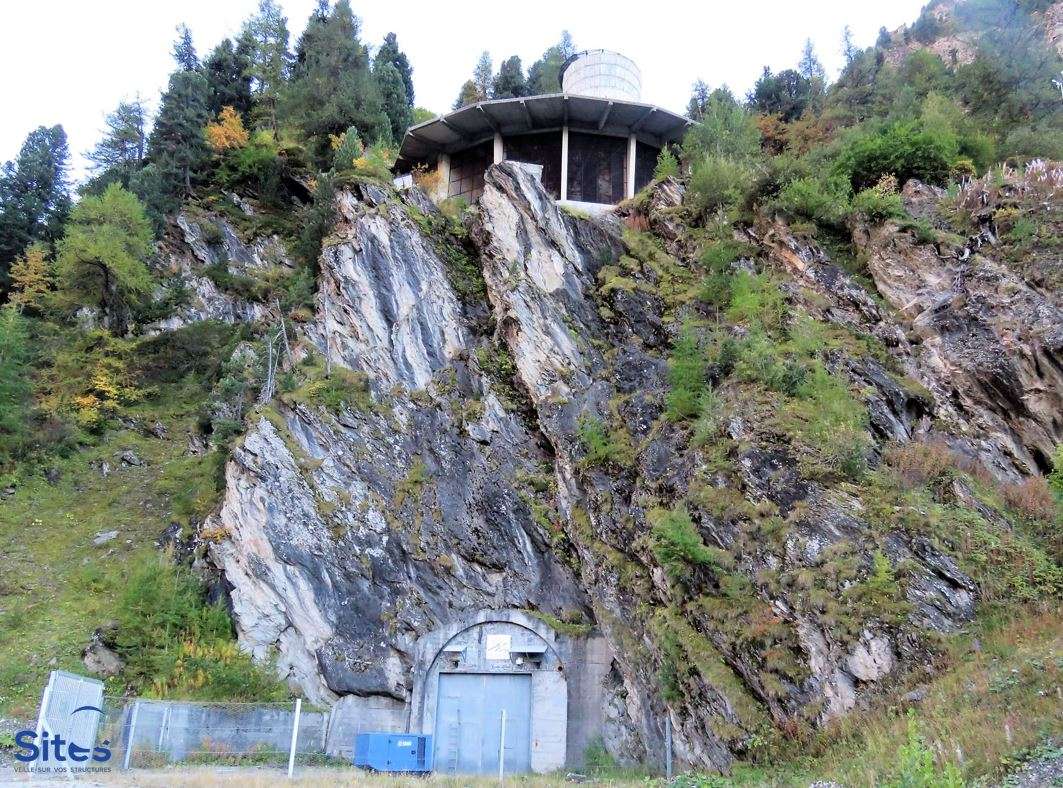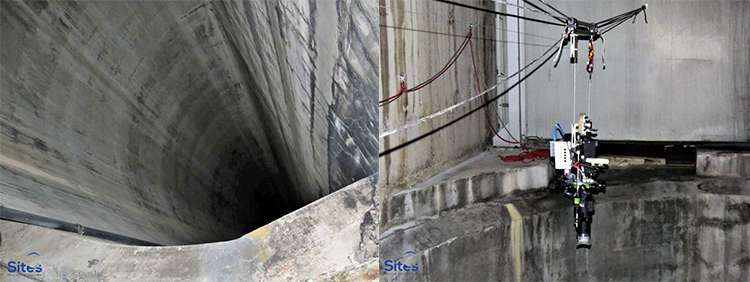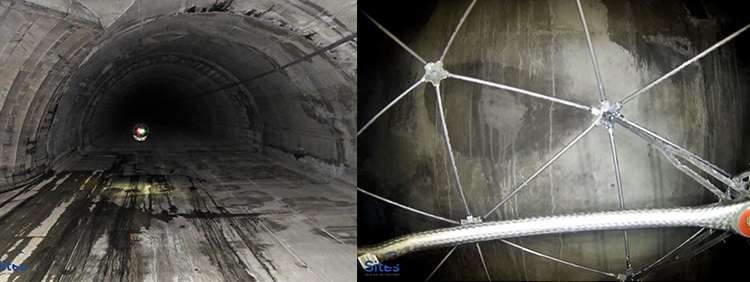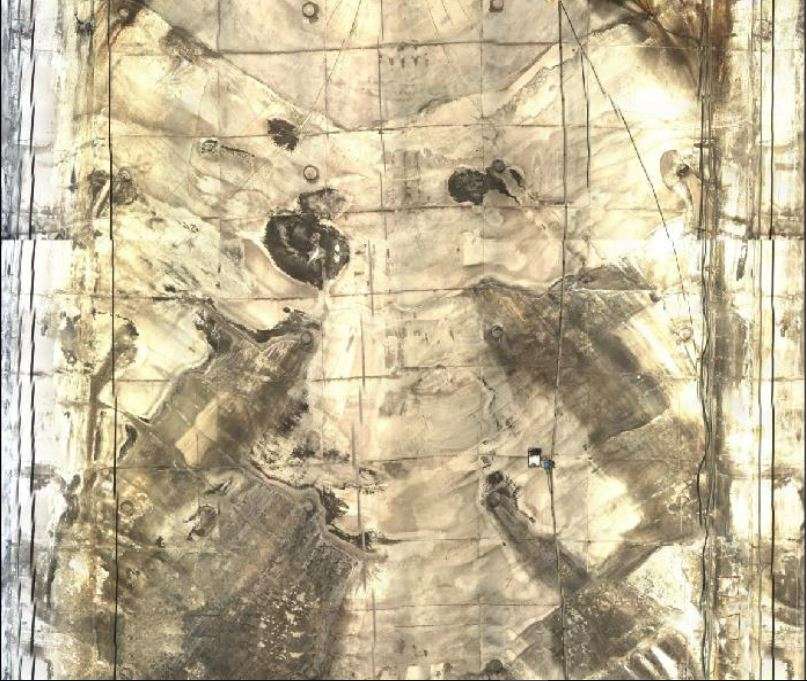How did we inspect the Fréjus tunnel’s 700 m-deep ventilation shafts? We take a look back at an exceptional mission carried out by SITES’ teams using innovative methods.
The Fréjus Tunnel links Italy and France via a 12.9 km gallery between Modane and Bardonecchia. Commissioned in 1980, it is the ninth longest road tunnel in the world. It clocks up traffic of more than 1.5 million vehicles per year, making it a key international crossing point in Europe. SFTRF and its Italian counterpart, SITAF, are responsible for operating the tunnel. As part of its role, SFTRF commissioned a civil engineering assessment specialist to inspect four ventilation shafts. These shafts circulate fresh and foul air. SITES used its ScanTubes® inspection service range to respond to the operator’s requirements and successfully complete the mission.
Exceptional structures with unique inspection requirements
The ventilation shafts located on either side of the border present technical and operating restrictions:
– On the French side, accessible via a mountain road there is a shaft head at an altitude of 1950 m;
– There is no lighting;
– The vertical shaft is 700 m deep. This shaft is divided into two by a concrete wall to separate fresh air and foul air.
– On the Italian side, there is a well head at an altitude of 1750 m and two separate structures (fresh air and foul air), both of which are approx. 700 m long and inclined at 45°.
– Inspections therefore had to be carried out on four separate pipes (two on the French side and two on the Italian side);
– In order to enable access and ensure the safety of personnel during interventions, the ventilation system was usually shut down, and traffic reduced as a result. Work could only be done between midnight and 3 a.m. (when traffic was completely closed) or between midnight and 5 a.m. when alternating traffic was permitted.

The ScanTubes® service range: designed for the most demanding settings
The ScanTubes® service range automates the digitisation of linear structures for diagnostics purposes. For this operation, a version dedicated to vertical structures was deployed. A pod equipped with 10 industrial cameras controlled by an acquisition unit took shots at regular intervals. Positioning sensors completed the system. The inspection teams can therefore produce exhaustive, high-resolution photo coverage of the entire shelf space. The system was moved via a winch at the top of the shaft. The winch is designed to ensure the camera system’s stability and prevent rotation. The device lowering speed is restricted to 0.5 m/s to ensure optimal overlap between images, enabling the post-processing needed for analysis. A flash positioned under the pod provides the lighting required for each shot.
The ScanTubes® service considerably reduces the time required to visit a structure. In this instance, the teams only needed the five-hour closure window to complete each shaft inspection. This is three to four times shorter than the time required to carry out such an operation using conventional means such as rope-access technicians. Given the constraints on international road traffic in the Fréjus tunnel and the cost of completely or partially shutting down such an asset, every minute saved is precious. Most importantly, these kinds of inspections using robotic tools represent a significant achievement in terms of how they reduce personnel’s exposure to hazards.

The top of the shaft and the ScanTubes® prepared for descent
To complete the data capture, a drone for inspecting confined spaces (an ELIOS® model designed by FLYABILITY) was used. The drone’s protective cage makes it possible to fly in contact with the ventilation shaft and take high-resolution (video) footage. The first 50 m from the foot of the ventilation shaft were inspected using this complementary method. The team consists of a drone pilot and a civil engineering expert who can guide the investigations and check that image quality is sufficient for in-depth analysis back in the office. Fewer than ten flights over a total duration of two hours were required to carry out the inspections.
This intervention demonstrates how this type of tool can eliminate the need to install scaffolding or deploy rope-access technicians, which would require prolonged shutdowns and extremely restrictive safety measures.

Using visual data in image processing
The acquired data is processed in the office. The aim is to generate a digital clone of the structure from which an inspector can identify, measure and assess all apparent faults. Image processing makes it possible to reassemble all HD 360°images. This assembly uses photogrammetry processing and georeferencing data to create orthophotography of the ventilation shafts.
The digital clone then enables an inspector to detect cracks of as little as 0.3 mm, with an absolute positioning accuracy of less than 1 cm. The inspector digitises all visible faults and updates a database, which is then used to assess the structure’s health and to plan any works which may be required. Digital technology lets users go back to faults an unlimited number of times. Second opinions can be provided should the inspector require confirmation. This type of information exchange is not possible during physical interventions where only faults identified during the visit are taken into account.

Partial orthophotography
In conclusion, conducting the inspection in the Fréjus tunnel using the ScanTubes® service provided several advantages:
– The speed with which the photos were taken. The cost of immobilising a key structure for cross-border traffic was thereby greatly reduced and managed;
– The ability to monitor development of the fault over time, thanks to precision measurements and positioning;
– Increased fault detection quality, since the inspection itself is not carried out in-situ under pressure from operating constraints and closure slots. With the Fréjus tunnel, it is not hard to imagine the scale of the challenge involved in detecting cracks several hundred metres from the ground in a completely dark environment.
– Digital archiving, which allows users to look back at defects or questionable areas as often as they like;
– Inspection of certain parts of the structure using a drone designed to operate in a confined environment. This complementary methodology makes it possible to obtain a high-resolution image from several viewpoints. Because deployment is easy (taking less than 15 minutes) and data acquisition is quick, the structure’s downtime is considerably reduced.
– The creation of a database about the structure’s life cycle, which can be used for research projects or for running automatic detection software.
– The ScanTubes® inspection process’ duration and methodology reduces personnel’s exposure to hazards.

